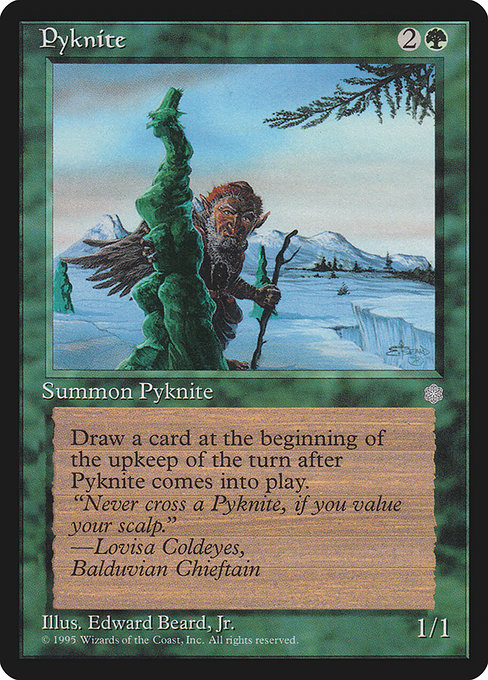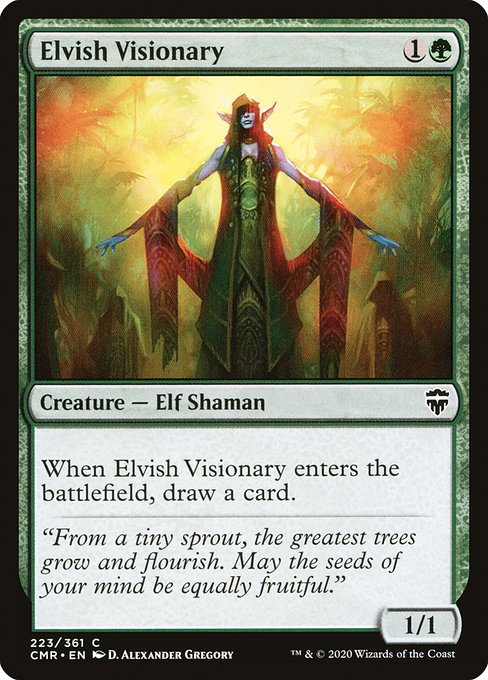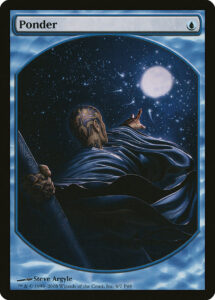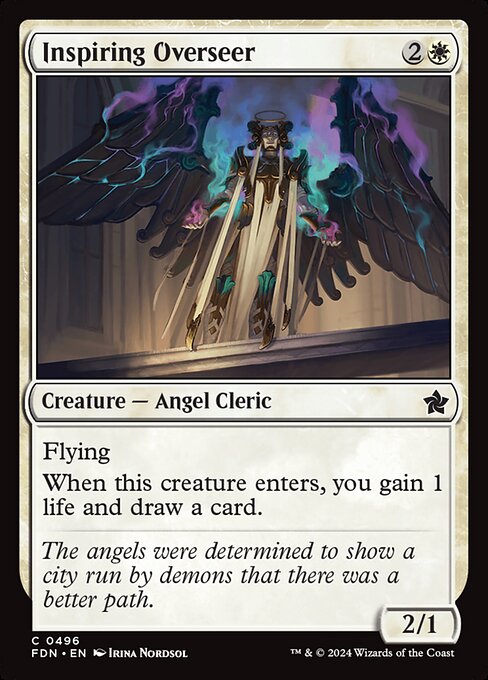Inspiring Overseer is the undisputed best common in Streets of New Capenna. It’s centered in white, which has access to the most powerful mechanic (Shield Counters). It works with well in white-blue fliers, triggers Alliance, and is easy fodder for Casualty. All of this is mere added flexibility for a creature with an already high baseline power level. However, this design is both relatively simple and a concept with ancient roots that has shifted and mutated over time. So today, we’re going to examine the design of Capenna’s common queen and how we got to where we are today.

Once upon an Ice Age
Back in 1995, the concept of cantrips—spells which replace themselves by drawing a card—was quite new. Ice Age dipped its toes into the water with the safer but memory-taxing slow-cantrips that today only see play in cards like Mishra’s Bauble and Portent. And included in Ice Age was Pyknite, a creature with an enters-the-battlefield effect before Visions really popularized the concept with creatures like Man-o’-War the following year.
And, well, Pyknite‘s pretty weak. So was Striped Bears in 1997’s Weatherlight. Today creatures are much, much stronger than they were twenty five years ago, but we still see plenty of cards like Nimble Innovator, Rhox Oracle, and Joraga Visionary, where you pay a hefty premium for a cantripping creature. Sure, there’re also cards like 1998’s Wall of Blossoms and 2015’s Faerie Miscreant that cheaply cantrip, but they have downsides and restrictions.

A seed of power
2008’s Elvish Visionary was a game-changer. It was a huge step up from Merchant of Secrets—by recognizing that a vanilla one-mana 1/1 creature is worth less than a mana (it preceded Memnite by only two years), it allowed essentially the entirety of the mana cost to cover the two mana required for cantripping. At the same time, it used a highly relevant creature type that had just been heavily supported in both Onslaught and Lorwyn blocks. The end result is an incredibly powerful creature in the right circumstance that’s hardly impressive without that synergy.
As time has gone on, Magic has permitted more creatures to not require the full two mana for cantripping. Owlbear is a fairly strong creature at four mana, and its cantrip only costs one mana. Sarulf’s Packmate accepts that Centaur Coursers tend not to be great anymore and so cantrips for just a smidgen over one mana. Cloudkin Seer did the same, and both it and Sarulf’s Packmate ranked among the strongest commons in their sets.
At the same time, Commander has created increased need for white card draw, so these advancements in blue and green have bled over into white. Spirited Companion is a twist on Elvish Visionary where instead of a highly relevant creature type, it’s an enchantment (a highly relevant type in both Neon Dynasty Limited and eternal enchantment-focused decks). Farsight Adept and Priest of Ancient Lore were quick innovations that preceded Inspiring Overseer, giving white equal, if not superior, status as the cantripping creature color.

The trouble with cantrips
I’m beginning to worry that Wizards is overusing powerful cantripping creatures. The nice and terrible thing about cantripping creatures is that they’re straightforward card advantage, which is essentially a universal good (especially in Limited). They’re a great way to punish slow decks full of removal spells, since if they use a removal spell or trade with your cantripping creature, you’re up a card. However, there’s a substantial difference between a Spirited Companion (where the creature is negligible on its own), and an Owlbear (where the creature is a real threat), just as there’s a difference between a Nimble Innovator (where you pay a hefty price for the privilege of cantripping) and a Llanowar Visionary (where you pay almost none).
Every year for the past several years, one of the best common creatures (if not the best) was a creature with relevant stats and an all-but-free cantrip. 2021 had Organ Hoarder and Sarulf’s Packmate, 2019 Cloudkin Seer, and 2020 Llanowar Visionary. This occurred amidst a backdrop of later-banned Constructed powerhouses Uro, Titan of Nature’s Wrath and Omnath, Locus of Creation, which themselves were part of a years-long banning season that included Rogue Refiner, another card whose only crime was freely drawing cards for far too little mana. Now, Inspiring Overseer joins its common brethren as a slightly improved and colorshifted reprint of Cloudkin Seer.
Making cantrips essentially free and putting them on decent threats effectively invalidates most of what else is going on in a set. Synergy is about combining cards to make them worth more than the sum of their parts, but this effort is generally futile in the face of creatures which both demand an answer and are resilient to being answered. While I appreciate putting power points into threats which use new mechanics like Sarulf’s Packmate or set themes like Organ Hoarder, I still think the pendulum has swung too far in this direction.

Inspiring Overseer is particularly awkward because it has nothing to do with demon mobster crime families nor their mechanics, and it claiming the spotlight makes the story’s timeline weird, but the core issue is the same as we’ve been seeing for years. I hope it’s the last superpowered common cantripping creature we see for a while, as we’ve had more than enough formats defined by them. While they’re a sweet tool in moderation, I’d much rather see them pushed up into higher rarities or used more sparingly so card advantage can be a little bit less facile to come by. But perhaps we’ll see even more in the years to come, as evidenced by Inspiring Overseer being made just the littlest bit stronger than the already dominant Cloudkin Seer.
Zachary Barash is a New York City-based game designer and the last commissioner of Team Draft League. He designs for Kingdom Death: Monster, has a Game Design MFA from the NYU Game Center, and does freelance game design. When the stars align, he streams Magic (but the stars align way less often than he’d like).

